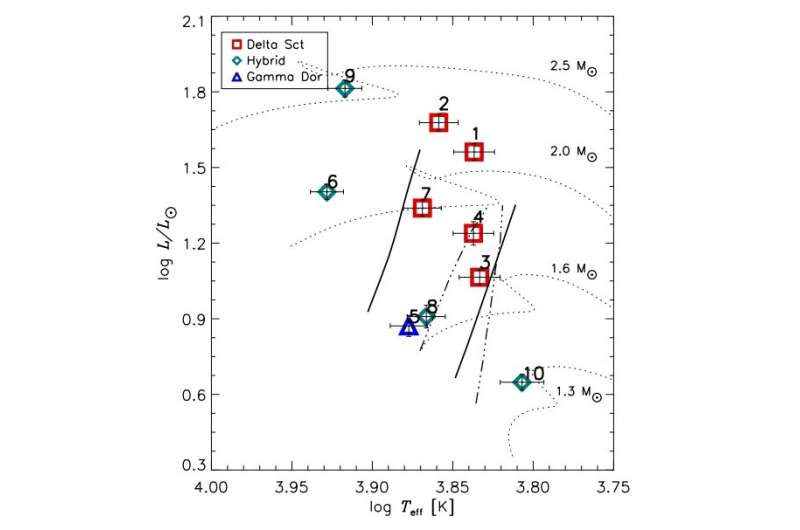Position of the variables in the Hertzsprung–Russell diagram. Credit: Alicavus et al., 2022.
By analyzing the data from NASA's Transiting Exoplanet Survey Satellite (TESS), Turkish astronomers have detected 10 new pulsating variable stars, including five Delta Scuti variables. The finding is reported in a paper published August 25 on the arXiv pre-print server.
Detecting and studying variable stars could offer important hints into aspects of stellar structure and evolution. Investigation of variables could be also helpful for a better understanding of the distance scale of the universe. In general, there are two main-sequence A-F type pulsating variables: Delta Scuti and Gamma Doradus stars.
Delta Scuti stars are pulsating variables with spectral types between A0 and F5, named after the Delta Scuti variable in the constellation Scutum. They exhibit radial and non-radial pulsations spanning periods from 20 minutes to eight hours. Studying pulsation behavior of Delta Scuti variables could help us advance our knowledge about stellar interiors. When it comes to Gamma Doradus stars, they are dwarf and/or sub-dwarf variables with a spectral type of A7-F5 and periods on the order of one day.
Now, a team of astronomers led by Filiz Kahraman Alicavus of the Çanakkale Onsekiz Mart University in Turkey, report the finding of 10 new pulsating variables by inspecting the TESS database.
"In the current study, we present a part of our northern TESS field research to discover unknown Delta Scuti type variables. (...) We took the TESS data from the MAST [Barbara A. Mikulski Archive for Telescopes] archive. Only SC [short cadence] TESS data were checked to find these kinds of variable stars," the researchers wrote in the paper.
In result, Alicavus' team discovered five Delta Scuti stars, one Gamma Doradus variable and four hybrid systems. The newfound Delta Scuti variables, designated TIC 25537276, TIC 177422294, TIC 252554307, TIC 279874050 and TIC 370599803, have effective temperatures between 6,812 and 7,394 K, while their bolometric luminosities are within the range of 0.69-2.23 mag.
TIC 308447073 is the only Gamma Doradus variable identified in the study. Its effective temperature is estimated to be 7,539 K and its bolometric luminosity was measured to be approximately 2.69 mag.
The remaining four variables received designations TIC 367910480, TIC 395520454, TIC 400502366 and TIC 431375592. Their effective temperatures are between 6,411 and 8,476 K. The bolometric luminosities of these stars range from 0.27 to 3.25 mag. They were classified as hybrid variables as they show both Delta Scuti and Gamma Doradus type oscillations at the same time.
The researchers explained that they classified the 10 variables based on the frequency spectra and the values of pulsation constant of these stars.
"The final pulsation type classification was made by considering the frequency ranges and pulsation constants of the stars," the astronomers wrote in the study.
More information: O. Kirmizitas, S. Cavus, F. Kahraman Aliçavuş, Discovery of new Delta Scuti Stars. arXiv:2208.11915v1 [astro-ph.SR], arxiv.org/abs/2208.11915
© 2022 Science X Network
























